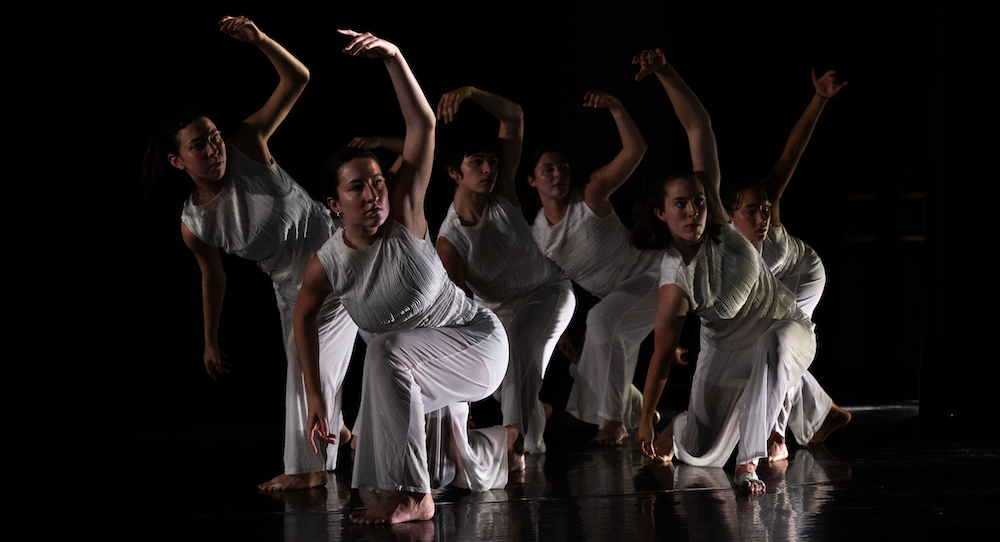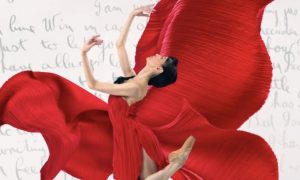Ballet RI’s Blackbox Theater, Providence, RI.
August 25, 2024.
There’s an unfortunate stereotype of contemporary concert dance: erudite, insular, inaccessible to the average person. With authenticity and joy in spades, The Choreography Project’s Here and Now demonstrated just how much of a welcoming party it can be. It was the last program that the Providence, RI-based organization presented under the name of The Rhode Island Women’s Choreography Project – soon after rebranded to The Choreography Project to be in closer alignment with their guiding light of “supporting female, non-binary, trans, and all artists whose identities are underrepresented in the dance world.” Everyone is, and will be, welcome to the party.
The program opened with Mira Göksel’s fresh and jubilant peachfuzz. Göksel described it as a dance depiction of the sort of big, vibrant wedding that they want to have: celebrating both their Turkish culture and queer love. It began with a more legato quality, the performers savoring each moment and movement nuance. This felt like a sweet, comforting way to get to know the personas in this little world filling the blackbox stage.
Soon enough, however, the energy went from a simmer to a boil. What cooked up was delicious and nourishing to the soul. Göskel’s movement vocabulary seamlessly blended contemporary dance shapes and qualities with footwork from Middle Eastern folk dance (Dakba, for one) – which the dancers executed with pure vivacity.
Speaking of culture, without knowing all that much about Turkish culture, seeming touchpoints of tradition – such as a beautifully detailed wedding dress, red ribbons thrown up and all over the stage, and sharing oranges without hands – came off asfully real to me. I felt warmly welcomed into this celebration, and I wanted to stay a while, smiling and dancing along in my seat.
Minami Kikuchi’s ONE followed. It was less overtly a celebration, but – in its own intentional and cohesive way – a celebration of unity over division. Kikuchi described how when she first came to the U.S., she noticed people of various backgrounds and identities coming together to create. This work felt like a kinetic painting of that idea.
Dancers shook with agitation in the beginning of the piece, disconnected in the dim stage space. Yet their turmoil softened as they discovered each other: more than just seeing, but connecting and feeling. Finding the hand of another, dancers received touch and support for physical weight. Tension softened into easy spirals and clear channeling of momentum.
Interestingly, in juxtaposition to that idea of unity, dancers very much brought their own interpretations to the movement vocabulary and timing; it didn’t seem like Kikuchi drilled into them to shape each count exactly the same or have exactly the same timing. Perhaps the work demonstrated that there isn’t a juxtaposition there at all; unity and individuality can find harmony, can dance together and create something profound.
Dara Nicole Capley’s Strange Attractors notably changed the tone – but offered something just as uniquely thoughtful and memorable. Capley noted that she had to explain a bit of abstract math to illuminate her idea – and brought visuals to help with that (with Leah Misano serving as an elegant Vanna White). I chuckled to myself to think that I never know just what dance might teach me! Essentially, the concept inspiring this work was that in nature, we can find an understanding of chaos: a beautiful, and perhaps reassuring, idea indeed.
The dancers (Katherine Bickford, Hannah Franz and Aileen Leon-Echeverria) began moving to a funky tune (“I Can Change” by LCD Soundsystem). Rolling hips and snaking spines, blending jazz dance vocabulary with something more released and grounded, brought something quite sultry. Their costumes of rhinestones, white negligees, and fishnet tights certainly matched that quality. These dancers fully committed to the bit, and seemed to be having the time of their lives doing so. “Dance can be a party,” I thought, “it doesn’t have to be so stuffy!”.
This atmosphere shifted with Misano returning to take their signifiers of sultry femininity: rhinestones, garters, hair clips, and even makeup (they removed it with wipes, right there onstage). They then danced individual, and seemingly much more vulnerable, movement. What is there underneath all of those cultural signifiers? Who are we with all of that stripped away?
Toward the end of the piece, they returned to movement from earlier – which they had danced bejeweled and slyly smiling. This time they were much more contemplative and unique in their movement. The lights went down on them as they did so. It wasn’t where I expected the piece to go, but I was fascinated and moved by where it did.
Margot Aknin’s vivacious and heartwarming Flip Side followed intermission. Aknin explained how, as someone who’s often drawn to the deep and vulnerable, she wanted to do something more lighthearted. She certainly achieved that; this work was, in short, a total blast. Costumes and several tracks of a bygone ragtime era (from the likes of Billie Holiday and Ella Fitzgerald, for example) instilled a classic elegance. Jitterbug-style partnering and jive footwork fit right in with that era – even while peppered with movement vocabulary of this day and age.
Rather than feeling anachronistic, these various qualities came together into something smooth and pleasing. Little comedic touches also grounded the movement in true human moments. The ensemble created these with as much confidence and skill as they executed fan kicks and multiple turns. It felt like an Exhibit A of the wonder that can happen when artists take the leap into something that they haven’t yet fully explored.
The Contents, by Morgan Dubay and danced by Haley Andrews, explored a relatable experience: finding emblems of our past as we clean and organize storage spaces. While not as much an energetic celebration as other pieces in the program, it had its own joy and heart: a celebration of memories.
Dubay said that she chose the score (Elegy (for Cam) by Julius Rodriguez) in order to explore all of its complex nuances. Andrews made them all memorably visceral.There can be so many emerging memories as we sift through items of our past, and – even if small – each has meaning. Andrews danced each movement, whether big or small, with intention and significance.
She traversed the stage space as if these memories were drawing her down various avenues of mind and heart. Just as she did in the beginning, Andrews closed the piece by pointing here and there upwards: categorizing, compartmentalizing, organizing. Enough of Memory Lane, time to buckle down again…relatable indeed! For a young choreographer, Dubay showed a quite sophisticated ability to kinetically convey these ideas without being overly literal.
Ana G. Delgado Cruz’s DunDun closed the program – talk about a party in a dance! “Dun dun” is a drum commonly played in her home of Puerto Rico, Delgado Cruz explained, and thus its sound a sort of pulse through her culture and life. Dancers moved together to the strong pulse in the score (from various artists, mix engineering by Simon Deery) – moving through more culturally-based dance fluently integrated with contemporary dance vocabulary.
With dancers grounding deep and rippling through spines, West African dance influence shone through. Rolling hips and stepping quickly front and back, Latin dance forms did just as much. Costumes of various bright colors created a rainbow across the stage. Personality and humanity was the brightest of all, however – both of the dancers and of Delgado Cruz (bright and bubbly in her introduction, she encouraged audience members to cheer the dancers on…which she definitely would be doing from the wings, she said).
It hit me that each work similarly seemed to reflect the personality of the choreographer – at least of what they showed us as they introduced their works. The best parties are those at which everyone feels and acts fully like themselves, I then thought. Thank you to The Choreography Project for the reminder that in dance we can find and lose ourselves in equal parts: releasing into pure joy, returning to ourselves in the fall.
By Kathryn Boland of Dance Informa.















